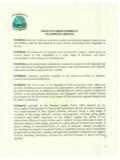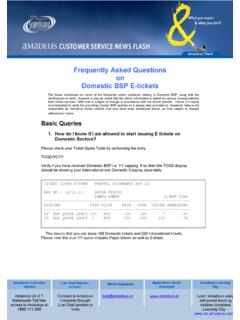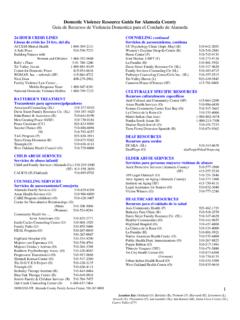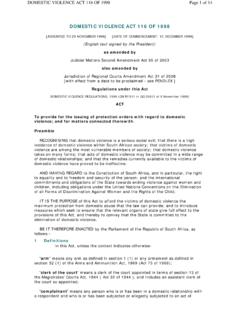Transcription of The Ontario Domestic Assault Risk Assessment …
1 The Ontario Domestic Assault Risk Assessment ( odara ) The Ontario Domestic Assault Risk Assessment ( odara ), a procedure to identify the risk of future assaults against intimate partners, was developed by the Ontario Provincial Police and the Ontario Ministry of Health and Long Term Care in response to the May/Iles and Hadley inquest recommendations. It was also a result of recommendations by The Joint Committee on Domestic Violence to the Attorney General of Ontario in 1999. It was the first empirically developed and validated Domestic violence risk Assessment tool to assess risk of future intimate partner violence as well as the frequency and severity of these assaults The odara is a single Assessment that is available for use in policing, victim support services, health care, and corrections.
2 It is an actuarial risk Assessment , and the information it provides about how an offender s risk compares with others enables policy-level decisions about how to assign available resources to offenders according to their level of risk.. There are no professional restrictions and no fees required for scoring the odara . Our evaluation shows that scoring accuracy is improved following training, which is available online at We strongly recommend use of the full scoring criteria, available in the odara and DVRAG manual published in the appendices of this book: Hilton, N. Z., Harris, G. T., & Rice, M. E. (2010). Risk Assessment for domestically violent men: Tools for criminal justice, offender intervention, and victim services.
3 Washington, DC: American Psychological Association. History The odara is the result of collaboration between the Ontario Provincial Police and researchers at Waypoint. The OPP's Behavioural Sciences and Analysis Section is mandated to provide criminal investigation support services and training of a behavioural nature to OPP and other criminal justice agencies within the Province of Ontario . In 2001, this research team was awarded a quarter-million-dollar grant by the federal government to develop risk assessments for wife Assault recidivism. The funds also supported research on the mental health issues of women assaulted by their partners. In 2003, the team was recognized through an award for Team Endeavours from the Ontario Women in Law Enforcement.
4 In 2004, the first article on the 2016 Waypoint Centre for Mental Health Care 500 Church Street, Penetanguishene ON L9M 1G3 (705) 549-3181 ext. 2610 odara Fact Sheet odara , its development, and its first cross validation, was published in the journal Psychological Assessment . Subsequent research has demonstrated the odara s predictive accuracy among men with a correctional record, incarcerated men, male sex offenders, and female offenders. Published meta-analyses indicate that the odara performs as well as or better than other published IPV risk Assessment tools Development The odara was created from research on nearly 600 cases from OPP and municipal police forces. Using multiple regression techniques, the researchers found that 13 questions were the most highly predictive of future violence.
5 The risk of Assault can be predicted with large accuracy using these questions alone, reducing the need for a comprehensive Assessment in order to evaluate risk of re-offence. The 13 yes/no questions cover the accused man's history of violence and antisocial behaviour (police record for Domestic Assault , police record for nondomestic Assault , prior correctional sentence, prior failure on conditional release, violence outside the home, Domestic Assault during pregnancy, substance abuse), details of the most recent Assault (physical confinement, threats of harm, victim reported fearing future assaults at time of the Assault ), and the victim's personal circumstances (number of children, children from a prior relationship, barriers to support).
6 Interpretation The odara is an actuarial risk Assessment such that its scores rank Domestic offenders on risk for repeated Domestic violence. Thus, a male Domestic offender can be placed into one of seven categories of risk. For example, a score of 0 places a man in the lowest risk category; 9% of men in the odara research studies fell into this category, and 7% of these men met the criteria for Domestic recidivism within a follow up of about 5 years. A score of 7 or more places a man in the highest risk category; 6% of men fell into this category, and 74% of these men met the criteria for Domestic recidivism. Higher scores on the odara also indicate that an accused assaulter will commit more assaults, commit them sooner, and cause more injury (in a range of injury from none to lethality) than an accused with a lower score.
7 Validation Studies The odara s predictive accuracy has now been demonstrated in validations by the original researchers and by other researchers. This work includes samples in Canada, the USA, and Europe, as well as female perpetrators and cases of dating violence. These studies are available in our bibliography, click here to view. 2016 Waypoint Centre for Mental Health Care Pg 2 odara Fact Sheet Frequently Asked Questions 1. Can the odara be used for cases of dating violence? Yes. Some of the validation studies have scored the odara using dating violence as the index Assault and/or in the definition of reoffending. The literature on violence risks indicates that the major factors are criminal history and antisocial behaviour, and there is no evidence that risk is lower among men who are not currently in a dating relationship.
8 For these reasons, it is acceptable to use the odara in cases of dating violence. The item scoring criteria remain unchanged, however, as there is no research yet that uses dating violence in the definition of prior Domestic assaults. 2. Has the odara been validated for female offenders? Yes. The odara predicted intimate partner violence recidivism in two studies to date. The odara can be used to identify the women most at risk of reoffending. However, women reoffend at a lower rate than men do. Further research is required to develop an actuarial table to identify absolute risk associated with odara scores among women. 3. Can the odara be used when there is a risk of lethality? Yes. Higher odara scores indicate more severe future assaults, and our current research has found that men who subsequently committed Domestic murder ranked in the highest risk category.
9 So, although the odara does not specifically predict the occurrence of lethal Domestic violence, it can be used in cases where severe and potentially lethal Assault is a concern. 4. Does the odara predict assaults that are not known to the police? Yes and no. The odara calculates the likelihood of assaults known to police, so the likelihood of any Assault , with our without police involvement, could be different from the stated recidivism rate. On the other hand, higher odara scores indicate that a man is more likely than other domestically violent men to commit future assaults. This rank order is expected to be stable over time and regardless of whether there are assaults that the police don t find about.
10 5. Can I draw a conclusion about risk using only the odara score? Yes, the odara can be used validly as the only Assessment to measure risk of Domestic violence. More information is not required in order to score the odara . Adjusting the score by adding other information could result in lower accuracy. 2016 Waypoint Centre for Mental Health Care Pg 3 odara Fact Sheet odara Training odara 101: The Electronic Training Program: An interactive e-learning program for assessors to learn to use the odara any day of the year and at any time that fits their schedule. This project has been made possible by a grant from the Ontario Ministry of Community Safety and Correctional Services. Click here to register: or click here to sign in: There is no professional restriction on the use of the odara , but training has been shown to improve scoring accuracy.








